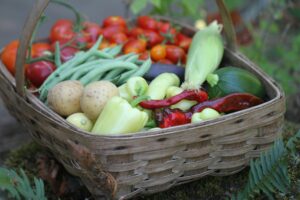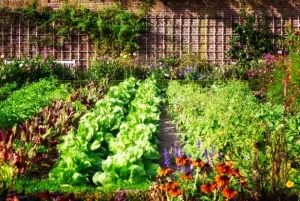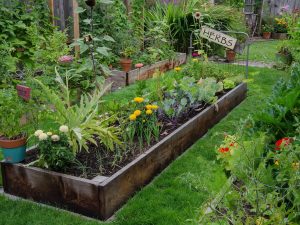Growing Guide
Are you a coffee fanatic?
Do you consider yourself an average coffee patron?
Do you stay away from it?
Either way, coffee has been a big part of our daily lives for hundreds of years. One could even say coffee helped fuel the industrial revolution. How is that possible? Well, as we will explain later in this blog, during the 16th and 17th centuries, coffee houses became very popular among business owners and scholars who enjoyed sharing ideas and debating industry leading perspectives. This systematically resulted in the Tontine Coffee House acting as the first New York Stock Exchange overlooking Wall Street. Once the Buttonwood Agreement was signed in 1792 establishing organized security trading, the house leader would call out the list of stocks and bonds available for the day and the brokers would respond with their bids and offers, while drinking coffee.
Why Do We Love Coffee So Much?
If you’re like most people, sometimes we can feel a bit overwhelmed by the tasks of the workday and the obligations of home life, not to mention the occasional bad night of sleep. Thanks to coffee, we experience several health benefits that help manage these responsibilities. These include but are not limited to increased energy, brain function, memory, mood, and reaction time.
There is no wonder why coffee is the second most popular beverage in the world behind water. This was especially true during the 1500s in Europe where a polluted water supply encouraged people to drink beer. People quickly decided to ditch the morning buzz and go for the morning brew.
And, in terms of successfully maximizing the value of human capital, business owners replaced the beer pitcher in the break room with a pitcher of coffee.
How Much Do You Love Coffee?
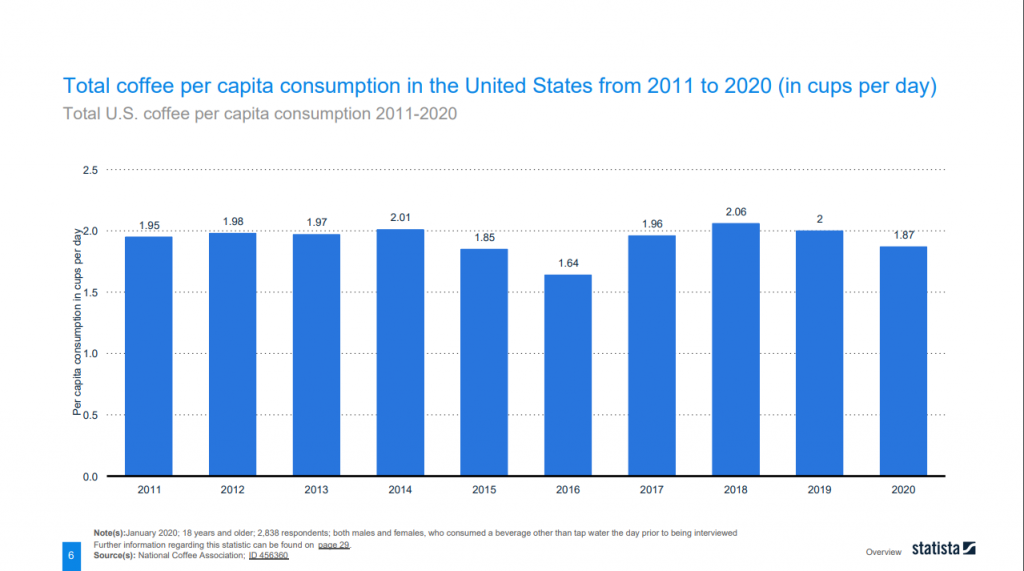
The average coffee drinker in the United States had 1.87 cups of coffee per day in 2020, down from over 2 cups in 2018. (Source: Statista)
This volume of consumption can get a bit pricey, especially now as more coffee house chains like Starbucks, Dunkin Donuts, and Tim Hortons continue to find ways to drive up prices for their coffee.
How Much Do We Spend On Coffee?
According to investing app, Acorns, the average American spends roughly $1,100 per year on coffee. This breaks down to $92 a month. That’s a lot! Think of all the things you could be spending $92 on every month.
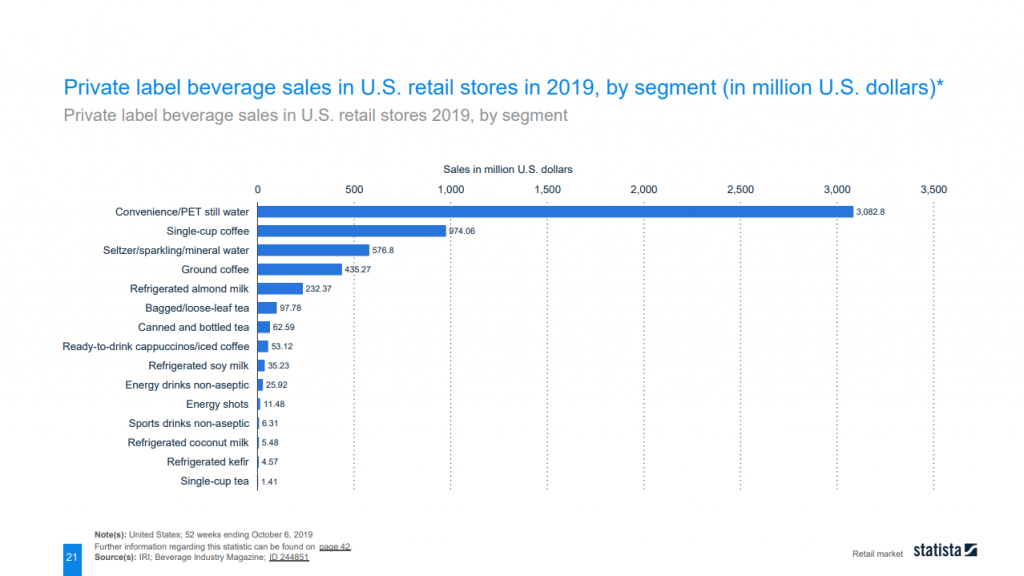
Moreover, Americans collectively spent over $974 million dollars on single cups of coffee in 2019, behind only plastic water bottles. (Source: Statista) This data falls in line with historic knowledge of coffee being the 2nd most popular beverage in the world.
Before we explain the process of growing your own coffee plants, first lets backtrack and find out how coffee became so popular.
Origin of Coffee
Coffee has largely been a societal staple for centuries. Though the exact origin is unknown, scholars and historians agree that this special drink became popular in the Arabian Peninsula. This makes sense considering one of the four most common coffee plants is named Arabica.
By the 15th and 16th centuries, coffee had spread to other parts of the Middle East in areas like Persia, Syria, and Egypt thanks to local travelers who enjoyed the taste.
The effects of coffee, such as alertness and focus, helped to popularize coffee houses – called qahveh khaneh – where people would come together to socialize, debate, and share stories with one another.
“Penny Universities” became a popular term in Europe because for a penny, you could buy a cup of coffee and indulge yourself in higher level conversation.
People across this region liked it so much they began to drink it before performances, sporting events, and other social activities because it allowed them to enjoy the event, without feeling sleepy or drowsy like they would with alcohol or marijuana.
As it spread so quickly through Europe and to the New World by European travelers, some would hesitate out of misinformation or fear, calling it the “bitter invention of Satan.”
After a series of localized uproars throughout the continent, Pope Clement VIII ushered in a wave of reassurance when he took a drink of the mysterious beverage and ended up liking it so much that he gave the people his personal approval.
Fast forward to the 21st century and you can’t find a school, business, or grocery around the world that doesn’t have it – either in the form of raw coffee cherries, coffee beans, grounds, or the actual drink.
This level of popularity was once coined into a popular phrase by Thomas Jefferson when he said, “Coffee – the favorite drink of the civilized world.”
How Many Types of Coffee Plants Are There?
With over 60-70% of the world’s coffee being produced from Arabica beans, it makes total sense why we see that name on so many coffee bags at our grocery store. There are many reasons as to why Arabica beans are so popular; but they are not the only beans to choose from.
When we think about how coffee is classified and sold, we generally consider factors like roasting characteristics or country of origin. While this information is useful in determining what to anticipate from a particular coffee, it does not provide the complete picture. In this section, we’ll examine the many varieties of coffee and what makes them special.
The four main types of coffee beans are:
- Arabica (Coffee arabica)
- Robusta (Coffee caniphora)
- Liberica (Coffee liberica)
- Excelsa (Coffee liberica var. dewevrei)
To get an in-depth understanding of each bean, we will provide a description of each.
Arabica
Arabica, as mentioned above, is the most popular variety of coffee bean sold in America. Due to the bean performing well in regions with high elevation and good rainfall, Brazil acts as the worlds biggest exporter and serves as the leading coffee harvesting country in the world.
The bean itself has a more delicate touch of flavor to it, offering a slightly sweeter side to the world of coffee bean taste. Arabica bean plants are more fragile than others so pruning is particularly important, as well as attention to weather cycles and environmental changes.
Robusta
These beans come second to Arabica and understandingly so. They are filled with high amounts of caffeine, offering a burnt or rubbery taste. However, because of these higher levels of caffeine, Robusta coffee plants are much more successful in warding off pests, withstanding environmental changes, and maintaining hardiness under differing altitudes. The flavor profile of Robusta coffee beans bode particularly well in Europe, the Middle East, and Africa where communities enjoy extremely strong coffee as part of their culture.
Coffee harvesters can find ways to save money on the strength of their coffee by implementing a 2 part Arabica to 1 part Robusta combination which will go together to create a “signature” blend of strong coffee. Although, if you ask us, it just seems like they’re cutting corners.
Liberica
Carrying fruity and flowery aromas, Liberica was considered a grand treat. Although much harder to grow than Robusta beans, they were once immensely popular three centuries ago. During this time, a major disease affecting Arabica coffee plants, called “coffee rust”, had swept through the world, eliminating most of the Arabica plants providing the planet of its coffee.
Farmers and government agencies alike went out to discover acceptable alternatives for coffee because it was such a valuable product even at that time. Thus, the Liberica plant was harvested and sold at a notable volume, initially in the Philippines, and being the only provider, the country’s economy boomed substantially as a result. The Philippines had been a U.S. colony up to this time, but as its economy expanded, it declared its independence. As a result, the United States implemented severe economic sanctions cutting off supplies to the country. As a result, the Liberica coffee bean was doomed to failure in the worldwide market since no other country was able to catch up to the Philippines’ pioneering output.
Excelsa
Despite technically being a part of the Liberica family, Excelsa is incredibly distinct and boasts a unique flavor profile. Showing characteristics of dark and light roast coffees at the same time, this fruity coffee tantalizes the tongue with its tart underbelly.
Excelsa, like Liberica, is grown mostly in Southeast Asia and represents a small portion of daily coffee drinkers due to its high costs and difficulty to grow.
How To Grow Your Own Coffee Plant
Now that we have a better understanding of coffee and how it became popular, lets jump into discovering how to grow your own coffee plant at home. Remember to stay patient, use preparation, and adhere to the growing process defined below.
Step 1: Find a location – Indoor vs. Outdoor. Coffee plants need an abundance of space as their roots will grow deep and wide into the ground. Additionally, the coffee plant is especially dependent on the environment. Cool-warm and moist climates, like those in the tropics, are what the coffee plant will love so where you end up starting your coffee plant will highly determine your success. That is not to say you can not grow your coffee plant outside, you will just need to take extra steps to ensure the environment is stable – like planting in a greenhouse.
Step 2: Environment – Wherever you end up growing your coffee plant, one thing must remain the same – your environment. Arabica coffee plants, for example, have an optimal growing temperature of 65°-70°F and will love rich soil as well as few pests. They also prefer non-direct sunlight during early growth and adequate soil space for roots. Allow the soil to drain well, not to smother the plant of water, but water enough so the soil stays moderately moist. Pooling water is not good for the coffee plant. Furthermore, choose nutrient rich soil with a pH close to 6. If you can maintain these conditions, you will give your coffee plant the best chances for growth.
Step 3: Find seeds – Coffee plants produce coffee cherries, which range in colors from green – unripe – to dark red – ripe. Inside these cherries are beans. To start growing your own coffee plant, you will need to find seedlings which are the cherries or green coffee beans. It will be very unlikely to grow a coffee plant from an already roasted coffee bean.
Step 4: Maintain care routine – As the plant begins to grow, consistently check in with the root size as to make sure the roots have room to grow. Most of the time, a good benchmark for repotting is when the plant reaches eight inches and again when the plant reaches two feet.
Water frequently to ensure the soil remains moist, but not too wet or too dry. You will also want to check the pH level of the soil every so often and fertilize when needed to keep the plant in its comfort zone. Regular pruning, especially with an Arabica coffee plant, is needed to make sure that the plant is using the nutrient from the soil properly.
Step 5: Be patient – The process of coffee plants, from planting to cherry bearing, could take a couple years and even after the plant starts producing cherries, it could take over a year before you begin enjoying the fruits of your labor. The average wait time to get to ripe coffee cherries, from initial planting to maturity, could take anywhere from three to four years.
How To Brew Your Own Coffee
Congratulations! Now that you have ripe coffee cherries, you can extract the beans from them and begin the process of turning coffee beans into your personal morning brew.
Step 1: Dry the cherries – From the moment of picking these ripe cherries, you must begin drying them until the moisture level reaches 11%. There are several methods to this but essentially, coffee beans are covered in a layer of mucilage (called the parenchyma) that you will need to remove as part of drying the cherries.
Step 2: Remove the parchment envelope – Coffee beans are covered by another layer called the parchment envelope (endocarp) that will also need to be removed. 11% moisture levels will be reached after this step. You can test the moisture with a moisture meter.
Step 3: Milling the beans – You’re not done there. The beans must have the entire dried husk removed. The dried husk represents the exocarp, mesocarp, and endocarp. From there, it is recommended to polish the beans to remove any remaining skin or parts of the dried husk.
Step 4: Roasting – These beans must now be roasted which can be done by heating them up. Most roasting machines keep a 550°F temperature until the inside of the bean reaches 400°F and the caffeol begins to come out. The caffeol is the potent oil locked inside the bean until these temperatures are met. This process is technically called pyrolysis, which is the essence of roasting.
Step 5: Grinding and brewing – After the beans have been left to cool down, grind them up – either with a blender or another similarly functioning machine, and add to your coffee maker. The object of grinding the beans is to extract the most caffeol as possible so the finer the grind, the more potent the coffee will be.
Growing, harvesting, and preparing each batch of coffee is an amazing adventure that begins with fresh seedlings and continues all the way to the final sip at the bottom of the cup. We hope you enjoyed this article and hope that it inspires you to grow your own coffee plants!
Sources
- “Types of Coffee Beans and What Sets Them Apart”, DistrictRoasters.com, 13 March 2019. https://districtroasters.com/blogs/news/types-of-coffee-beans. Accessed 21 September 2021.
- “How To Grow A Coffee Plant At Home”, RealGoodCoffeeCo.com, 4 November 2019. https://realgoodcoffeeco.com/blogs/realgoodblog/how-to-grow-a-coffee-plant-at-home. Accessed 21 September 2021.
- “Coffee Bean Types and Their Characteristics”, CafeDirect.com, https://www.cafedirect.co.uk/shop/coffee-bean-types-and-their-characteristics/. Accessed 21 September 2021.
- Conway, Jan. “Coffee market worldwide – statistics & facts”, Statista.com, 12 February 2021. https://www-statista-com.suproxy.su.edu/topics/5945/coffee-market-worldwide/. Accessed 21 September 2021.
- “The History of Coffee”, NCAUSA.org, https://www.ncausa.org/about-coffee/history-of-coffee. Accessed 21 September 2021.
- “Top 3 Reasons Why People Drink Coffee”, PremiumWaters.com, 28 May 2019. https://premiumwaters.com/blog/reasons-why-people-drink-coffee/. Accessed 21 September 2021.
- Backman, Maurie. “One-Third of Americans Spend More on Coffee Than on Investing”, Fool.com. 22 January 2018. https://www.fool.com/retirement/2018/01/22/one-third-of-americans-spend-more-on-coffee-than-o.aspx. Accessed 21 September 2021.
- Schwartz, Elaine. “Why Coffee (Might Have) Caused the Industrial Revolution”, Econlife.com, 3 April 2016. https://econlife.com/2016/04/coffee-history-stock-markets-and-innovation/. Accessed 22 September 2021.
- Scott, Michon. “Climate & Coffee”, Climate.gov, 19 June 2015. https://www.climate.gov/news-features/climate-and/climate-coffee. Accessed 22 September 2021.


